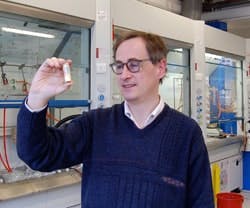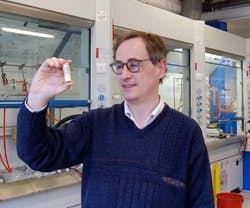Waste CO2 edges toward feedstock role
Likely moves in the U.S. to limit greenhouse gas emissions (New president will grapple with greenhouse gases), coupled with significant efforts already taking place elsewhere are making the question of how to deal with recovered carbon dioxide all the more pressing. Simply storing the gas, such as in salt domes and depleted coal seams, is a widely cited option but one that poses long-term safety and other challenges. So, finding ways to productively use the CO2 clearly makes sense. Researchers at the University of Newcastle, Newcastle upon Tyne, U.K., believe they’ve identified a role for the gas as a feedstock.
Figure 1. Michael North holds catalyst that enables cyclic carbonate production at atmospheric pressure and ambient temperature. Photo: University of Newcastle.
Michael North, a professor of organic chemistry, and his team at the university have developed a method to convert waste CO2 into cyclic carbonates. They note that substantial demand already exists for such carbonates in established applications, e.g., in solvents, paint strippers and biodegradable packaging, and that the materials also may serve as a feedstock for anti-knock agents for gasoline.
The catalytic reaction of CO2 with an epoxide to form a cyclic carbonate is well known, note the researchers, but until now has required high purity CO2 as well high temperatures and pressures. They have developed an “exceptionally active” catalyst, a dimetallic aluminum(salen) complex, that allows the reaction to use flue gases and to take place at atmospheric pressure and ambient temperature. This dramatically reduces energy input, by obviating all the energy needed to purify, heat and compress the CO2, explains North.
The process could consume a significant amount of CO2, he believes. In the U.K. alone, “to satisfy the current market for cyclic carbonates, we estimate that our technology could use up to 18 million tonnes of waste CO2 per year, and a further 30 million tonnes if it is used as an anti-knocking agent,” says North. (The cyclic carbonates can be converted into dimethyl carbonate, which Texaco has reported to be an excellent anti-knocking agent, he notes.)
“At present we have only done the reaction on a gram scale… Preliminary results indicate that we can expect to remove at least 20% of the CO2 from a typical waste stream. We see no byproducts and, in particular, do not form polycarbonates. The cyclic carbonate we make is 100% pure,” he notes.
“We have just secured two grants to optimize the process. What we aim to do is develop an immobilized version of the catalyst so that we can conduct a flow reactor and run the process continually rather than in batch mode. This will allow us to address issues such as catalyst lifetime and poisoning,” North adds.
“I think the main remaining challenges are to immobilize the catalyst and then simplify its structure as much as possible. Once this is done and we have engineering data related to optimal flow rates, etc., then we can look at scaling the process up. We hope to have all the necessary data in about a year’s time,” he notes. At that time, pilot-plant trials for both batch and continuous flow modes should begin, he says.
“We are looking at establishing a spin-out company to further the development of the process. If pilot plant studies are successful, we would hope to move to a demonstration facility within the next few years,” says North.
In industrial implementation, he foresees plant flue gases being piped directly to a continuous reactor. “Our technology would be just another module added onto the back of an existing power station, alongside NOx and SOx extractors, etc.”

